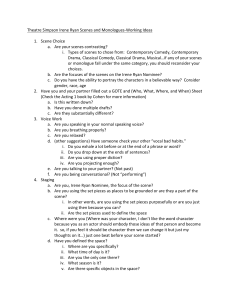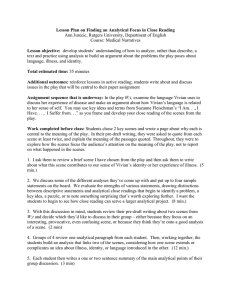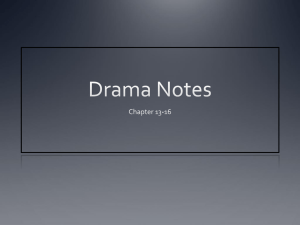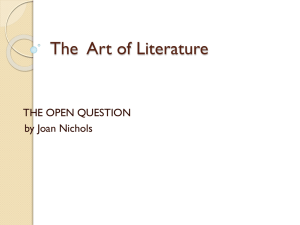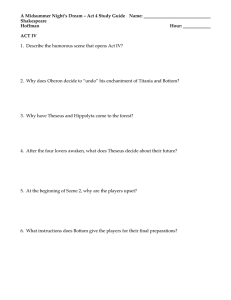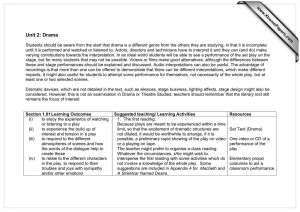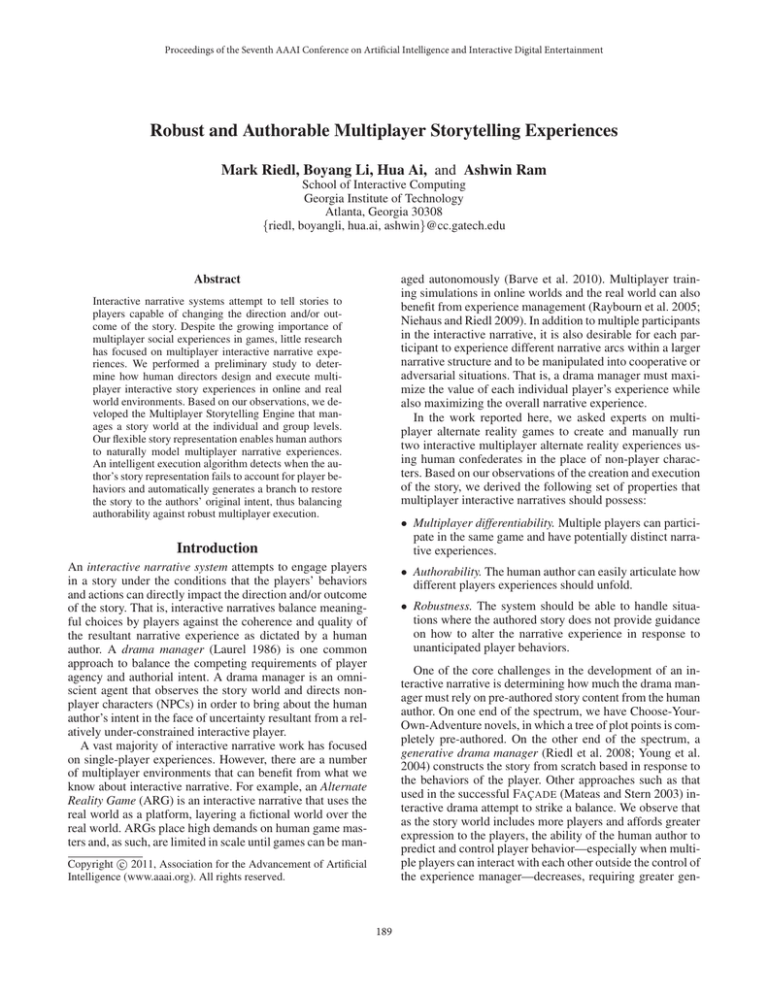
Proceedings of the Seventh AAAI Conference on Artificial Intelligence and Interactive Digital Entertainment
Robust and Authorable Multiplayer Storytelling Experiences
Mark Riedl, Boyang Li, Hua Ai, and Ashwin Ram
School of Interactive Computing
Georgia Institute of Technology
Atlanta, Georgia 30308
{riedl, boyangli, hua.ai, ashwin}@cc.gatech.edu
aged autonomously (Barve et al. 2010). Multiplayer training simulations in online worlds and the real world can also
benefit from experience management (Raybourn et al. 2005;
Niehaus and Riedl 2009). In addition to multiple participants
in the interactive narrative, it is also desirable for each participant to experience different narrative arcs within a larger
narrative structure and to be manipulated into cooperative or
adversarial situations. That is, a drama manager must maximize the value of each individual player’s experience while
also maximizing the overall narrative experience.
In the work reported here, we asked experts on multiplayer alternate reality games to create and manually run
two interactive multiplayer alternate reality experiences using human confederates in the place of non-player characters. Based on our observations of the creation and execution
of the story, we derived the following set of properties that
multiplayer interactive narratives should possess:
Abstract
Interactive narrative systems attempt to tell stories to
players capable of changing the direction and/or outcome of the story. Despite the growing importance of
multiplayer social experiences in games, little research
has focused on multiplayer interactive narrative experiences. We performed a preliminary study to determine how human directors design and execute multiplayer interactive story experiences in online and real
world environments. Based on our observations, we developed the Multiplayer Storytelling Engine that manages a story world at the individual and group levels.
Our flexible story representation enables human authors
to naturally model multiplayer narrative experiences.
An intelligent execution algorithm detects when the author’s story representation fails to account for player behaviors and automatically generates a branch to restore
the story to the authors’ original intent, thus balancing
authorability against robust multiplayer execution.
• Multiplayer differentiability. Multiple players can participate in the same game and have potentially distinct narrative experiences.
Introduction
An interactive narrative system attempts to engage players
in a story under the conditions that the players’ behaviors
and actions can directly impact the direction and/or outcome
of the story. That is, interactive narratives balance meaningful choices by players against the coherence and quality of
the resultant narrative experience as dictated by a human
author. A drama manager (Laurel 1986) is one common
approach to balance the competing requirements of player
agency and authorial intent. A drama manager is an omniscient agent that observes the story world and directs nonplayer characters (NPCs) in order to bring about the human
author’s intent in the face of uncertainty resultant from a relatively under-constrained interactive player.
A vast majority of interactive narrative work has focused
on single-player experiences. However, there are a number
of multiplayer environments that can benefit from what we
know about interactive narrative. For example, an Alternate
Reality Game (ARG) is an interactive narrative that uses the
real world as a platform, layering a fictional world over the
real world. ARGs place high demands on human game masters and, as such, are limited in scale until games can be man-
• Authorability. The human author can easily articulate how
different players experiences should unfold.
• Robustness. The system should be able to handle situations where the authored story does not provide guidance
on how to alter the narrative experience in response to
unanticipated player behaviors.
One of the core challenges in the development of an interactive narrative is determining how much the drama manager must rely on pre-authored story content from the human
author. On one end of the spectrum, we have Choose-YourOwn-Adventure novels, in which a tree of plot points is completely pre-authored. On the other end of the spectrum, a
generative drama manager (Riedl et al. 2008; Young et al.
2004) constructs the story from scratch based in response to
the behaviors of the player. Other approaches such as that
used in the successful FAÇADE (Mateas and Stern 2003) interactive drama attempt to strike a balance. We observe that
as the story world includes more players and affords greater
expression to the players, the ability of the human author to
predict and control player behavior—especially when multiple players can interact with each other outside the control of
the experience manager—decreases, requiring greater gen-
c 2011, Association for the Advancement of Artificial
Copyright Intelligence (www.aaai.org). All rights reserved.
189
erative power. We cast this as a tradeoff between authorability and robustness in the face of multiplayer differentiability.
We present an authorable narrative representation and
drama management execution process that lends robustness
to story progression in circumstances where players perform
behaviors unanticipated by the human author. Our representation is a specialization of Colored Petri Nets (Jensen 1996)
that models an interactive narrative as a process in which
multiple players flow from scene to scene. Our execution algorithm monitors for situations in which the Petri Net fails
to account for player actions and automatically constructs
new story branches to restore the Petri Net. In the remainder
of the paper we situate our approach in the context of related
work, briefly describe the preliminary study with expert alternate reality game directors that informed our approach,
and describe the representation and execution algorithm for
the Multiplayer Storytelling Engine (M U SE).
to author plot graphs that specify ordering dependencies
between possible plot points coupled with some form of
search to construct a policy for how and when a drama manager should intervene (Weyhrauch 1997; Nelson et al. 2006;
Sharma et al. 2010). The FAÇADE interactive drama (Mateas
and Stern 2003) also uses numerous hand-authored plot
points and character behavior decompositions coupled with
intelligent plot point and behavior selection. We note that the
greater the extent that a drama manager relies on humanauthored content, the greater the conflation of robustness
with authorability, as the system is only as robust in so far
that the author is able to anticipate all exceptions.
Generative drama management, in contrast, utilizes a narrative generation system to construct novel story sequences
whenever the player performs an exception (Riedl, Saretto,
and Young 2003; Young et al. 2004; Barber and Kudenko
2007; Riedl et al. 2008; Porteous and Cavazza 2009). Many
generative drama managers represent story as partial-order
plans and use a planner to generate and/or adapt the story
plan when necessary. Partial-order plans, in the case of storytelling systems, are graphs of events (or scenes) where arcs
capture causal and temporal relations. Partial-order plans
have been found to be good representations of narrative for
interactive systems for the following reasons: (a) partial ordering supports the parallelism of action that can occur in
stories; (b) the causal relations tracked by partial-order plans
are useful in identifying and handling exceptions; (c) causal
structures may correlate to certain aspects of aesthetics (Trabasso and van den Broek 1985); and (d) plan refinement algorithms can easily modify the existing story structure with
new scenes, thus implementing a form of continuous planning in response to player exceptions.
The IN-TALE (Riedl et al. 2008) system is a generative drama manager that starts from a pre-authored,
non-branching narrative plan and automatically generates
branches to handle exceptions. Our work is similar to INTALE in that we also start from an authored narrative specification; however, we start from a pre-authored structure that
captures branching and accounts for different narrative arcs
for different players, thus accounting for authorability, robustness, and multiplayer differentiability.
Historically, drama management has focused on singleplayer experiences. Winegarden and Young (2006) extended
the M IMESIS generative drama manager to account for multiple, distinct stories executing in the same environment.
Their work only considered load balancing between “story
servers” that may occasionally interfere with each other, but
didn’t consider the problem of managing multiple players
in the same narrative experience. Thus a novel contribution
of our work is an approach that specifically caters to multiplayer environments with the goal of using story to create
rich social interactions.
Related Work
Drama management, an approach to interactive narrative,
employs an intelligent and omniscient agent able to monitor the virtual world and intervene in the world to ensure
coherent story progression while simultaneously providing
the player with a large degree of freedom to act. These interventions are typically instructions to non-player characters
(NPCs) to engage with the player in a certain way, but may
also physically change the world. Riedl et al. (2003) categorize player actions in interactive narratives based on how
they affect the story the drama manager intends to tell:
• Contingent: An action performed in line with the author’s
expectations, thus progressing the story.
• Consistent: An action that changes the world in a way that
neither assists nor hinders progression of the story.
• Exception: An action that alters the world in a way that
hinders story progression by making a future player or
NPC actions illegal or nonsensical.
All drama managers are dependent to some extent on
knowledge provided by the human designer, which may include large fragments of story, primitive actions to be assembled at run-time, and/or rules on how to handle exceptions. The body of drama management work can be described in terms of a spectrum of knowledge requirements
running from author-intensive to generative, with associated
pros and cons. Author-intensive approaches have considerable authorial burden for any significantly large story world
(Bruckman 1990) but can be highly effective. Generative
drama managers can respond to a greater range of player behaviors but require story generation capabilities that are not
yet at the level of human storytelling competency. Space precludes an in-depth review of drama management techniques;
we note the most relevant work.
Balas et al. (2008) use hierarchical Petri Nets so that authors can completely manually construct and execute complex, branching plot structures. As with all heavily authored
approaches, success is dependent on the authors’ ability to
account for all possible exceptions at every point in the narrative. A common approach that strikes a middle-ground is
Preliminary Study
We conducted a preliminary, informal study to explore the
problem of multiplayer interactive narrative. We recruited a
director/screenwriter—an expert at crafting multiplayer alternate reality games—to write two multiplayer stories that
would engage a half dozen people periodically over several
190
are scenes, tokens are players, and transitions encode the
“ideal” progression of individual players through the scenes.
We chose the CPN representation because of ease of authoring branching story structures (Balas et al. 2008) as well as
similarity to the graphical construct devised by the director
in the preliminary study. The representation of players as tokens emphasizes a player-centric philosophy to storytelling,
allowing the author to determine how individual players flow
through a story structure. This is more expressive than a traditional branching story in that it can capture both branching
and parallelism; different players can be engaged in different
scenes at the same time.
While Petri Nets can represent many different types of
processes, a Petri Net assumes that all faults in a process
are handled with transitions. The preliminary study demonstrated that even experts cannot make fault-free narrative
structures in worlds that allow a high degree of player expression and agency. Consequently, we modify the CPN representation with information that allows an intelligent execution engine to dynamically modify the network structure
to handle unanticipated exceptions.
We represent a scene as a tuple m, A, B, P, E where:
hours. He was encouraged to use whatever visual representation he felt appropriate to capture his design.
The director created the stories as graphs, where each
node represented a scene, a general description of the type of
activity that those present in a particular place would engage
in such as meeting a character or stealing an item. Scenes
were meant to be able to unfold in many different ways and
have many different outcomes. Edges between nodes acted
as filters selecting which players would progress to which
subsequent scenes. Thus, players had the potential to experience different sub-stories. We also note that the director
used early scenes to “matchmake”—to cluster players into
groups—using lots of conditional edges and optional scenes,
and used later scenes to create periods of competition and
cooperation between groups of players.
As in the study by Kelso, Weyhrauch, and Bates (1993),
participants were recruited to play the game and confederate
actors assumed the roles of NPCs. The human director, with
the help of assistants, manually gave instructions to NPCs
based on the story graph. Each story was run five times over
the period of a week with different participants each time.
Space prevents further details in this paper; however, we
made the following relevant observations:
1. Despite the best efforts of the director to predict different
ways scenes could occur, exceptions happened.
2. The director responded to exceptions by creating new
scenes on the fly that, when possible, restored the players to the pre-authored scenes by the shortest reasonable
means.
3. In circumstances where the director deemed it too difficult
to restore players to the pre-existing scenes, the director
authored new chains of scenes that skipped pre-authored
scenes and rejoin the story at a later point in the graph or
to bring the story to an early resolution.
Based on our observations of the human director during
the preliminary study, we developed the Multiplayer Storytelling Engine described in the next section for managing multiplayer differentiable experiences in online or real
world story environments.
• m is the minimum number of tokens required to execute;
• A is a list of NPC agents that will participate in the scene;
• B is the body, the set of instructions to team surrogates;
• P is a set of predicates describing conditions in the world
that must be true prior to execution; and
• E is a set of predicates that will become true if the scene
executes successfully.
Unlike traditional CPNs, scenes do not execute until a minimum number of tokens are located at the scene and the precondition predicates are satisfied by the current world state.
Transitions dictate storytelling logic by determining
which scene each player token should experience next based
on what happened in the prior scene. That is, instead of implementing scene applicability constraints (which are handled by the scenes themselves), transitions act as a filter on
tokens. Transitions are thus constrained to be of the form
s1 , s2 , P,C where s1 and s2 are the originating and terminal scenes respectively, P is a list of players (or “any”) in
scene s1 to test, and C is a (possibly empty) list of predicates referencing players in P that will be tested against the
current state of the world. For example, a transition may select players that have, in the course of a scene, agreed to
help a particular NPC (e.g., the condition agree(player?,
npc?) is true), while another will select the opposite.
Figure 1 shows an example Petri Net for a M U SE story;
for clarity, it is simpler than that from the preliminary study.
There are eight players, who are tasked with solving a puzzle
in the first scene. The transitions on the first scene sort the
players based on those who solve the puzzle and those who
do not. The first half of the network engages the players in a
set of tasks that matchmake the players onto teams aligning
with a pirate, a witch, and a navy captain. The remainder of
the scenes bring the teams together in various cooperative
and competitive configurations. Note the use of transitions
to separate teams after they come together for joint scenes.
The Multiplayer Storytelling Engine
The Multiplayer Storytelling Engine (M U SE) combines
human-authored story content and a robust generative execution process that handles exceptions that are unanticipated
by the human author. The representation for story content
must support multiplayer scaling and be easily authorable
by designers without requiring programming or manipulation of complicated AI structures such as plans. To achieve
robust execution, the representation must support the ability
for an AI system to recognize and autonomously respond to
exceptions by dynamically generating a new branch to the
story structure. Thus, the approach behind M U SE is a collaboration between offline human storyteller and an online
AI system.
Story Representation
We represent multiplayer interactive narratives as a variation
of Colored Petri Nets (CPNs) (Jensen 1996), where places
191
⟨*, solve-puzzle⟩
⟨*, ~solve-puzzle⟩
Teach
magic
Recruit
swabby
⟨*, ~magic⟩
⟨*, ~hired⟩
Test
swabby
Blackmail
⟨*, magic⟩
Join
witch
⟨*, hired⟩
Join
pirates
Conscripted
by navy
Trick
pirates
⟨*, swabby⟩
⟨*, magic⟩
Find curing
amulet
Steal navy
treasure
⟨*, swabby⟩
Discover
curse
Figure 2: The scene execution algorithm.
⟨*, navy⟩
ticipated changes to the world. Scenes ready for execution
are placed into the plan, which may be empty or a complete
plan from a previous iteration, and the planner in invoked to
attempt to find a sound and complete partial-order plan. If
an exception has occurred, then the current world state will
not support the preconditions of one or more ready scenes,
requiring the planner to instantiate new scenes that bridge
between the current world state and the new scenes.
We use refinement search (Weld 1994) to construct the
plan. A refinement search planner takes a plan (empty or
otherwise) and searches for a sequence of modifications that
restores the soundness of the plan. In particular, a plan is not
sound if it has an open precondition flaw—a precondition of
a scene is not supported by the current world state or by the
effect of another, temporally prior scene. A data structure
c
− s j , records when preconcalled a causal link, denoted si →
dition c of scene s j is satisfied by an effect of scene si (or the
initial state).
The scenes from the Petri Net will wait until all of its preconditions are met by the executing plan. Scenes inserted by
the planner may involve players directly or may be maintenance scenes in which NPCs are directed to change the
world “behind the scenes,” for example having an NPC replace a missing prop. When newly planned scenes include
players, token locations are not adjusted, they remain in
place with the understanding that any other planned scenes
are meant to restore the applicability of the original scene.
The process of adding new scenes lends robustness to the
authored story. By instantiating scenes to bridge between
the unexpectedly modified world state and scenes from the
CPN, the system is effectively authoring new branches to
the story module. Thus the M U SE execution algorithm augments the author’s intentions by returning the world state to
one intended by the author so that the story can continue.
Hunt
pirates
Resolution
Figure 1: An example Petri Net story. Circles are scenes,
tokens are players, and boxes are transitions.
Story Execution
When a scene meets a minimum threshold of tokens, it is
marked ready for execution. Unlike typical executions of
CPNs, execution does not occur immediately. Instead the
system verifies whether the preconditions of “ready” scenes
hold for the current world state. This step is critical because the Petri Net models the author’s ideal progression but
the world may actually have changed in ways unanticipated
by the author; e.g., not captured by an explicitly authored
branch. There are two reasons this can happen. First, players
change the world in unanticipated ways. Second, scenes may
“fail”—they terminate without achieving all their effects.
The scene verification step proves that a scene can execute because its preconditions are true in the current world
state or can be made true given the current world state. If the
proof fails, the execution engine must take drastic measures
to reconcile the Petri Net with the state of the world so that
player experiences can continue. The story execution algorithm is given in Figure 2; the core parts of the algorithm,
scene verification and story repair are described below.
Scene Verification Once a scene is ready, M U SE verifies
that scenes meet their applicability conditions by building a
partial-order plan comprised of new scenes not in the Petri
Net. In this sense, a sound and complete plan is a proof that
any given scene can be executed barring any further unan-
Story Repair Scene verification is a process whereby
changes to the world state impact scenes as they become
ready. When a plan is in existence, further exceptions can
192
also derail the plan; players can cause changes to the world
state that will negate causal links in the plan.
Instead of rebuilding the plan from scratch, we use the
following plan repair approach adapted from Riedl et al.
(2008) to remove elements of the plan that are no longer
necessary due to world changes and to graft new scenes
into the plan that restore plan soundness. This process is a
form of continuous planning, which is, on average, more efficient than replanning from scratch and less likely to produce dead ends—executed scenes that never build toward
the story conclusion.
First, we distinguish between scenes added to the plan by
the Petri Net, SPetri , and scenes instantiated by the planner,
SPlan . There are some number of exceptions, represented as
causal links no longer supported by the current world state
and the scenes they point to. The system applies each of the
following repair strategies in sequence until one returns a
sound plan.
randomly selected to go first and the others are put on hold
until the first completes.
From the perspective of the execution system, scene execution means a message is sent to the NPCs participating
in the scene. In the case of our preliminary study, NPCs
were human confederate actors, however they could be autonomous agents. Implementation of autonomous character
agents is beyond the scope of the paper, but agents built
on reactive teleological frameworks such as those used in
FAÇADE (Mateas and Stern 2003) and IN-TALE (Riedl et
al. 2008) are most appropriate.
Scenes terminate when an adjudication routine—usually
built into the NPCs—believes that all the effects of the scene
have been achieved. Scenes may also be terminated when the
adjudication routine believes that one or more of the effects
will not be achieved. This is tantamount to failing the scene.
Authoring
Petri nets, with the constraints we impose, provides a degree of flexibility for authors to express their creativity without requiring authors to conceptualize their story designs as
partial-order plans. A Petri Net does impose some structure
onto the creative process in terms of breaking the story into
scenes and transitions. We found this to be similar to the way
our expert director preferred to break up the interactive multiplayer experience to account for different narrative arcs for
players. The Petri Net, as we have formalized it, allows the
author to think about the story experience from the perspective of the players and the sequence of scenes players will
encounter. The Petri Net formalisms also enables branching
and scene alternatives, as shown in Figure 1. The execution
system will handle the cases where exceptions are not caught
by pre-authored transitions.
For robust execution, M U SE authors must also provide a
domain theory, a description of how the world can change.
In this case, the domain theory is a set of extra scene templates that, like scenes in the Petri Net, provide preconditions and effects in the form of predicates. These extra
scenes are instantiated during scene verification and story
repair as means of restoring the Petri Net.
We trained the director from the preliminary study
to author interactive narratives using the M U SE representation, consisting of a Petri Net of scenes and a
domain library of extra scenes. The human director
authored highly specific scenes in the Petri Net (e.g.,
1. Remove the threatened causal links. Invoke planner to satisfy the now unsatisfied preconditions.
2. Remove the threatened links, the threatened scenes, and
any scenes in SPlan that are only on causal chains leading
through threatened scenes. Invoke the planner to satisfy
any unsatisfied preconditions that result.
3. Remove the threatened links, the threatened scenes, and
any scenes in SPlan or SPetri that are only on causal chains
leading through threatened scenes. Invoke the planner to
satisfy any unsatisfied preconditions that result. Advance
tokens in any scene in SPetri that were removed.
The first two strategies attempt to return the world state to
one that supports the author’s intended story flow.
The third strategy handles the case, as seen in the preliminary study, where authored scenes are bypassed. A scene
in SPetri is removed if its effects are preventing other scenes
in SPetri from becoming provably executable due to unanticipated changes in the world. If a scene in the Petri Net is
bypassed, what happens to the tokens located in that scene?
The tokens must be relocated at another scene. The execution engine simply forces the tokens to transition to subsequent scenes. Tokens can always move due to the constraints
we impose on transition structure. Forcing tokens to transition will result in one or more subsequent scenes in the Petri
Net becoming “ready.” It is likely that those scenes will have
preconditions that cannot be satisfied by the current world
state which will be handled by scene verification and subsequent calls to the story repair mechanism. Strategy 3 is
analogous to creating a new branch in the CPN, duplicating
human directors’ last-ditch efforts to save the story.
distract-guard-and-crack-safe (thief:Ethan,
players?, safe1, guard:Chris)) and general scenes
for the domain library (e.g., steal(thie f ?, players?,
ob ject?, owner?)), where question marks denote variables
to be bound when the plan is created. The general nature
of the domain library created by the director suggests
reusability in the sense that many distinct M U SE stories
could be authored alongside the same domain library. The
only requirements for this is consistent use of predicates.
Finally, an initial state must be provided that describes the
characters, places, and objects specific to the M U SE story,
as well as relationships between them all. These are used
when instantiating general scenes. An ontology of generic
proposition types enables authors to construct and describe
Scene Execution A scene is executed when it has a minimum number of tokens and all of its preconditions are satisfied by the current world state. That is, there is a valid execution plan and there are no scenes temporally ordered earlier. It may be the case that more than one scene executes in
parallel, which is allowed as long as there are no shared resources (NPCs, items, players, etc.) between parallel scenes
(Knoblock 1994). If there are shared resources, then one is
193
unique entities in predicate terms that match the preconditions and effects of scene templates in the domain theory.
The initial state is another way in which reusability of the
domain is achieved; when scenes are the same, many stories
can be told about different characters, places, and objects.
Laurel, B. 1986. Toward the Design of a Computer-Based
Interactive Fantasy System. Ph.D. Dissertation, Ohio State
University.
Mateas, M., and Stern, A. 2003. Integrating plot, character, and natural language processing in the interactive drama
Façade. In Proceedings of the 1st International Conference
on Technologies for Interactive Digital Storytelling and Entertainment.
Nelson, M.; Mateas, M.; Roberts, D. L.; and Isbell, C. L.
2006. Declarative optimization-based drama management
in interactive fiction. IEEE Computer Graphics and Applications 26(3):30–39.
Niehaus, J., and Riedl, M. O. 2009. Scenario adaptation:
An approach to customizing computer-based training games
and simulations. In Proc. of the 2009 AIED Workshop on
Intelligent Educational Games.
Porteous, J., and Cavazza, M. 2009. Controlling narrative
generation with planning trajectories: the role of constraints.
In Proceedings of the 2nd International Conference on Interactive Digital Storytelling.
Raybourn, E. M.; Deagle, E.; Mendini, K.; and Heneghan,
J. 2005. Adaptive thinking and leadership simulation game
training for special forces officers. In Proceedings of the
2005 Interservice/Industry Training, Simulation and Education Conference.
Riedl, M. O.; Stern, A.; Dini, D. M.; and Alderman, J. M.
2008. Dynamic experience management in virtual worlds
for entertainment, education, and training. International
Transactions on System Science and Applications 3(1):23–
42.
Riedl, M. O.; Saretto, C.; and Young, R. M. 2003. Managing interaction between users and agents in a multi-agent
storytelling environment. In Proceedings of the 2nd International Conference on Autonomous Agents and Multi-Agent
Systems.
Sharma, M.; Ontañón, S.; Mehta, M.; and Ram, A. 2010.
Drama management and player modeling for interactive fiction games. Computational Intelligence 26(2):183–211.
Trabasso, T., and van den Broek, P. 1985. Causal thinking
and the representation of narrative events. Journal of Memory and Language 24:612–630.
Weld, D. 1994. An introduction to least commitment planning. AI Magazine 15:27–61.
Weyhrauch, P. 1997. Guiding Interactive Fiction. Ph.D.
Dissertation, Carnegie Mellon University.
Winegarden, J., and Young, R. 2006. Distributed interactive
narrative planning. In Proceedings of the 2006 AAAI Spring
Symposium on Distributed Plan and Schedule Management.
Young, R. M.; Riedl, M. O.; Branly, M.; Jhala, A.; Martin,
R.; and Saretto, C. 2004. An architecture for integrating
plan-based behavior generation with interactive game environments. Journal of Game Development 1:51–70.
Conclusions
The M U SE approach was developed to directly address the
core requirements of multiplayer differentiability, authorability, and robustness for multiplayer interactive narratives in
online or real worlds. In particular, we modeled the way the
expert director/storyteller focused on individual player trajectories through a space of scenes in alternate reality games.
We note that stories can, and will, derail in multiplayer
real and online environments affording rich player expression. Robustness of the interactive narrative experience can
thus be achieved through a partnership between human authorial ability and an intelligent system capable of restoring authored scenes to executability. Given a robust drama
manager using our story representation, an drama manager
can provide players the ability to express their agency—
including the ability to perform actions that may derail the
story—while managing individual narrative experiences and
the overall group social experience. Multiplayer experiences
will continue to grow in importance. For these systems to
scale, they must allow authors the ability to craft engaging experiences for all players, individually and collectively,
without reducing players’ abilities to be expressive.
References
Balas, D.; Brom, C.; Abonyi, A.; and Gemrot, J. 2008. Hierarchical petri nets for story plots featuring virtual humans.
In Proc. of the 4th Conference on Artificial Intelligence and
Interactive Digital Entertainment.
Barber, H., and Kudenko, D. 2007. Dynamic generation
of dilemma-based interactive narratives. In Proceedings of
the 3rd Conference on Artificial Intelligence and Interactive
Digital Entertainment.
Barve, C.; Hajarnis, S.; Karnik, S.; and Riedl, M. O. 2010.
Wequest: A mobile alternate reality gaming platform and intelligent end-user authoring tool. In Proceedings of the 6th
Conference on Artificial Intelligence for Interactive Digital
Entertainment Conference.
Bruckman, A. 1990. The combinatorics of storytelling:
Mystery train interactive. Unpublished manuscript.
Jensen, K. 1996. Coloured Petri Nets: Basic Concepts, Analysis Methods and Practical Use, volume 1. Springer, 2nd
edition.
Kelso, M.; Weyhrauch, P.; and Bates, J. 1993. Dramatic
presence. Presence: The Journal of Teleoperators and Virtual Environments 2(1):1–15.
Knoblock, C. 1994. Generating parallel execution plans
with a partial-order planner. In Proceedings of the 2nd International Conference on Artificial Intelligence and Planning
Systems, 98–103.
194


